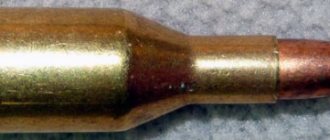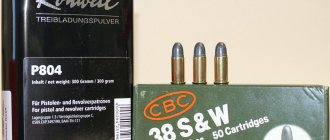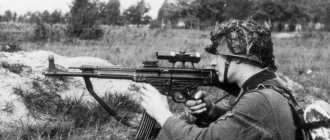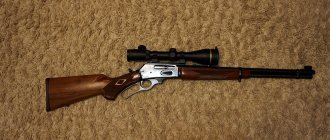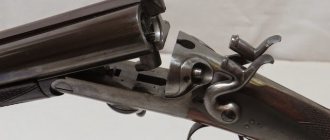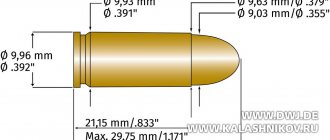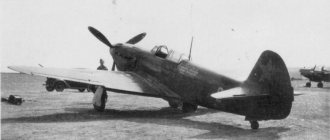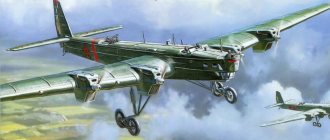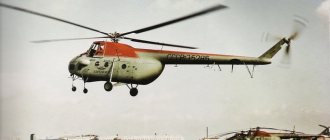Cartridge 5.45x39
The domestic 5.45x39 cartridge is a typical example of how the “arms race” stimulates the implementation of design solutions that are usually shelved. The idea of adopting a small-caliber cartridge with optimal ballistic characteristics as the main ammunition for small automatic weapons was proposed and justified at the beginning of the twentieth century, but found practical implementation only at the end of the last century.
We are, of course, talking about the works of the outstanding domestic designer V.G. Fedorov, who back in 1913 proposed his automatic rifle chambered for a reduced caliber 6.5 mm, and in the 1930-40s. comprehensively substantiated the advantages of small-caliber small-sized ammunition at effective firing ranges. For more than one decade, Fedorov consistently and persistently defended the ideas of small-caliber and then low-pulse ammunition, combining in his works not only a strong theoretical basis, but also rich practical material. However, for a number of reasons, including those of a purely technological nature, his work did not have practical implementation for a long time, until the notorious “arms race” factor came into play.
In recent years, an opinion has developed (not without taking into account the experience of the Afghan war and recent local conflicts) that the lethal effect of the 5.45x39 mm cartridge is not enough. Despite the fact that the transition to the 5.45 mm cartridge made it possible to improve shooting accuracy (by reducing recoil and increasing the direct shot range by almost 100 meters), many fighters operating in the Chechen conflict zone prefer the 7.62 mm AKM over their greater penetrating ability and destructive power. Supporters of the 5.45 mm cartridge argue that the problem is in the outdated 7N6 cartridge, and that with the new 7N10 (increased penetration) and 7N22 (armor-piercing) cartridges, 5.45 mm weapons are comparable in their combat characteristics to older models chambered for 7.62x39 mm.
New sleeve
At first, the 5.45-mm low-pulse cartridge used pyroxylin tubular powder of the VUfl 545 brand, but it was almost immediately replaced by varnish, the latest development of the Sf033fl brand (spheroid, thickness of the burning arch - 0.33 mm, phlegmatized) spherical graining with more high energy indicators and greater gravimetric density. The weight of the sample was chosen to be 1.44 g. Gunpowder brand VUfl 545 is currently used only for equipping 5.45 mm cartridges with bullets with reduced ricocheting ability - PRS. Initially, new bullets were loaded into re-compressed bimetallic machine gun casings “model. 43 years", which by that time had already been mastered in the production of domestic sports and hunting cartridges 5.6x39 and were used in the Bars hunting carbine. An experimental batch of about 2 million units was sent for testing to the Odessa Military District. However, when working in automatic weapons, a number of shortcomings appeared in the design of the cartridge case with a large slope and a too “thick” body. The use of new Sf033fl gunpowder in the cartridge made it possible to reduce the diameter of the cartridge case body without losing the required characteristics of the ammunition. The design of the reduced sleeve was carried out by the engineer of the development group, Lidiya Ivanovna Bulavskaya. At the stage of final testing, the new compact ammunition received the developer’s conditional index (TsNIITOCHMASH, Klimovsk) - 13MZhV. After the final fine-tuning of the bullet, carried out by cartridge production technologist Mikhail Egorovich Fedorov, it was assigned a 5.45 mm caliber, measured according to the domestic standard - by field. For some time, the new cartridge was produced with bimetallic sleeves, but at the stage of final development of the cartridge by 1967, more economical varnished steel sleeves were developed. The actual length of the cartridge case was 39.82 mm, but in the currently accepted international designation for this ammunition, the length of the cartridge case is usually rounded to 39 mm. To equip the 5.45 mm cartridge cases, a brass KV-16 igniter capsule with a diameter of 5.06 mm was used, which later received the army index 7KV1. A large team of ammunition specialists under the leadership of V.M. took part in the creation of the new ammunition. Sabelnikova. In parallel with the experiments on the ordinary one, work was carried out to create cartridges with special bullets - tracers and reduced speed. After testing the entire complex of new small-caliber small arms of the Soviet Army - machine guns and light machine guns - the 5.45x39 cartridge received the GRAU 7N6 index and was officially adopted for service in 1974, although its mass production began in the late 1960s. Simultaneously with the 7N6, ammunition with tracer bullets (index 7T3), cartridges with reduced bullet speed (index 7U1), blanks (index 7X3) and training (index 7X4) were accepted. The production of machine gun cartridges was launched at six Soviet cartridge factories - Ulyanovsk (No. 3), Amur (No. 7), Barnaul (No. 17), Frunzensky (No. 60), Lugansk (No. 270) and Tula (No. 539).
Caliber history: Soviet low-impulse 5.45x39 mm
How a domestic analogue of a low-pulse automatic cartridge was created during the “arms race”
As already written in earlier articles of our “cartridge” series, attempts to create ammunition in a caliber smaller than the standard “three lines” - that is, 7.62 mm - in Russia began even before the First World War. But if we know about the very first work with 6.5 mm cartridges at least from the memoirs of V.G. Fedorov, then with the developments of the Soviet period the situation is noticeably worse. We can only say with confidence that research in the field of high-velocity 5.6 mm bullets was carried out in the USSR before the start of the Great Patriotic War, in 1941, and after it, in 1949. But still, as in the case of the intermediate 7.62x39 mm, The main impetus for work on a domestic low-pulse cartridge was received only after reports of promising American developments. It was at this moment that ideas about switching to a new cartridge ceased to be the reasoning of ammunition specialists about the non-optimality of the “1943 model” and became a strict need to “catch up and overtake”. Looking ahead, we note that this time everything worked out.
Fedorov cartridge 6.5x57 mm
Although the initial requirements for the new rifle complex (machine gun + cartridge) can hardly be called excessive. It was necessary to provide:
1) Increasing the efficiency of hitting targets during automatic shooting by 1.5-2 times.
2) Increasing the range of a direct shot by 50% while reducing the recoil impulse by 25%.
3) Reducing the weight and dimensions of weapons (machine gun no more than 2 kg, single machine gun no more than 4 kg).
4) Further increase in the reliability of automation, maneuverability, manufacturability (reduction of labor costs by 50%).
One gets the impression that the point “and that the USSR anthem be played during the shooting” was omitted solely due to inattention. Even the Americans, who massively (and very riskily, as tests of the AR-10 showed) introduced aluminum and plastic on the M16, did not manage to get far from the weight of 3 kg. In the USSR, where requirements for reliability and operational strength were higher, and plastics technology lagged behind American ones, plans to create a machine gun weighing 2 kg looked like unscientific fiction. In addition, reducing the weight of the weapon would actually “eat up” the gain from reducing the recoil impulse - on the contrary, a lighter machine gun would “sausage” the AKM even more when firing. The latter was partly confirmed at the very beginning of the work - the experimental AO-25 assault rifle (weighing 2.55 kg) was inferior in accuracy to the one re-barreled for the experimental AKM cartridge.
5.56 mm NATO cartridge
Fortunately, with further research and experience, the sturgeon was still reduced to reasonable limits. So, if for the AKM the range of a direct shot at the chest figure was 350 meters, then for the new complex they justified the need to increase this value to 410 m - also a lot, but not the original 50%. There was quite a lot of controversy around the recoil impulse, since range, penetration, and much more were, by and large, “tied” to it. As a result, it was decided to choose this value equal to 0.50 kgf. This actually determined the caliber of the future cartridge - for the 6.5 mm version with this impulse the required range was achieved “at the limit”, and the 4.5 mm version raised serious doubts regarding lethality. The data obtained during the tests showed that their lethal effect would be 4 times worse than the standard “43 model”, so work on this option stopped - only 5.6 mm cartridges continued to be compared (5.45 mm when determined by the fields of the barrel bore) and 6.5 mm.
It is interesting that during further development, Soviet designers continued to “look back” at their Western colleagues. Thus, having received information about the problems that emerged with the AR-15 and 5.56 mm bullets during tests at low temperatures in Alaska, the USSR planned its own cycle of tests at low temperatures specifically to test the stability of bullets “in the minus”. And in the future, as far as possible - that is, the arrival of Western ammunition and weapons into the USSR - they were periodically compared with our “experimental”. Of course, fairly accurate knowledge of the characteristics of a foreign cartridge greatly facilitated the task of “doing better” - in particular, providing it with better ballistics due to a more advanced bullet shape.
During the work on the new cartridge, such “controversial” parameters as shooting through light obstacles (grass, bushes, tree foliage) were also tested. As recently, during testing by Kalashnikov expert V. Onokoy, there were no particular difficulties with the smaller caliber. Some of the bullets actually produced oval holes, indicating a loss of stability, but a similar problem was observed in the “43 model.”
Cartridge 7.62x39 mm, 1943.
The result of all these lengthy calculations, experiments and comprehensive tests was the adoption of the 5.45 PS cartridge (GRAU Index - 7N6) and its version with a tracer bullet into service in 1974. This completed the stage of creating a domestic analogue of a low-pulse automatic cartridge... and a long, sluggish war began between supporters of 5.45x39 mm and 7.62x39 mm.
Cartridge 5.45x39 mm
Despite the numerous and seemingly obvious advantages of 5.45 mm: lower weight of cartridges, higher bullet speed and flatness, which greatly facilitates the introduction of corrections for range and leads for moving targets, comparable, and for new types of bullets superior penetration - adepts 7.62 mm remain a very large cohort. It is not for nothing that even new generation assault rifles - AK-12 and AK-15 - were created for both types of ammunition. But for now, it is the 5.45x39 mm cartridge that remains the main cartridge of the Russian army - and, most likely, in the coming years it is unlikely that anyone or anything will be able to replace it in this role.
When working on the article, we used data from the monograph by V.N. Dvoryaninov "Combat cartridges of small arms"
Standard bullet
The 7N6 cartridge was equipped with a PS bullet with a conical bottom part 25.55 mm long and weighing 3.4 g. The bullet consisted of a bimetallic shell, a lead jacket and a blunt-pointed core made of grade 10 steel. There is a technological cavity between the upper end of the core and the bullet shell. The charge of gunpowder Sf033fl (since 1987 - grade SSNf 30/3.69) gives the bullet an initial speed of the order of 870-890 m/s. Subsequently, in connection with the increase in the level of target protection with personal protective equipment (PPE), the need arose to enhance the penetration ability of a conventional cal bullet. 5.45 mm, which was achieved through the use of a hardened core made of steel grades 65G, 70 or 75. A new modification of the 7N6M cartridge was adopted in 1987. The 7N6 and 7N6M cartridges do not have a special distinctive color marking. The subsequent appearance of body armor with titanium armor plates prompted the search for new ways to further increase the penetrating effect of bullets of the 5.45 mm cartridge. By 1991, specialists from the Lugansk Machine Tool Plant (No. 270) had developed a cartridge with a bullet of increased penetration (symbol of the 5.45 PP cartridge), which, after being put into service, received the GRAU 7N10 index. The bullet of the new cartridge received an elongated stamped hardened core made of steel grades 70 and 75 with a pointed top and a flat cut of the head with a diameter of about 1.8 mm. There was also a technological cavity in the head of the bullet. In addition to increasing the mass of the bullet to 3.6 g due to an increase in the length of the core, the mass of the powder charge was also slightly increased - up to 1.46 g. The new cartridge was adopted for service, but with the collapse of the USSR, the technological line for the production of 7N10 cartridges and the corresponding rights to development remained in Lugansk. In this situation, Russian manufacturers urgently had to “re-develop” the 7N10 cartridge, which later resulted in a number of upgrades to the 5.45x39 cartridge, which will be discussed in our next issue.
Encyclopedia of weapons
Cartridge 5.45x39 mm, Russia
A low-impulse intermediate cartridge, developed in the early 1970s by a group of Soviet designers as a counterweight to the American 5.56x45 cartridge (.223 Remington), which the Americans widely used in Vietnam in the 1960s.
Tactical and technical characteristics of 5.45x39 mm (7N10, with a bullet of increased penetration)
Caliber, mm — 5.45 Bullet diameter, mm — 5.60 Bullet length, mm — 25.5 Cartridge length, mm — 56.7 Case length, mm — 39.8 Bullet weight, g — 3.61 Cartridge weight, g — 10.2 Initial bullet speed, m/s — 870-890 Muzzle energy, J — 1360-1430 Loading chamber volume, cm — 31.56 Maximum gas pressure, MPa — 294
By the early 1970s, Soviet designers realized the promise of intermediate small-caliber cartridges: a small-caliber bullet, having a high initial velocity, provides a highly flat trajectory, has good armor penetration and significant destructive power, a small recoil impulse at the moment of firing has a beneficial effect on accuracy and accuracy of fire, and reducing the mass of the cartridge allows you to increase the ammunition carried by the shooter.
At the same time, work began on developing a new cartridge and weapons for its use. As a result, in 1974, the Soviet Army adopted a small arms complex consisting of a 5.45x39 cartridge, an AK-74 assault rifle (AKS-74) and an RPK-74 light machine gun. Later, the shortened AKS-74U assault rifle joined this family.
The 5.45-mm caliber automatic cartridge with a 7N6 steel core bullet and a 7T3 tracer bullet was developed under the leadership of V. M. Sabelnikov, a group of designers and technologists consisting of L. I. Bulavskaya, B. V. Semin, M. E. Fedorov , P. F. Sazonova, V. I. Volkova, V. A. Nikolaeva, E. E. Zimina, P. S. Koroleva, etc.
The 5.45 mm cartridge bullet is designed “on the verge of stability”, i.e. it flies steadily in the air and begins to “tumble” when it hits a denser environment - living tissue, wood, etc. This is achieved by shifting the center of gravity to the bottom of the bullet.
To ensure that the bullet loses stability in a dense environment, the bullet core is located in the bullet jacket with a gap in the front of the bullet. There is a void in front of the core and jacket in the front part, which ensures a shift in the center of gravity of the bullet and instability in a medium dense compared to air.
Bottle-shaped cartridge sleeve, bimetallic, without protruding flange, steel, varnished. The muzzle energy of the 5.45x39 cartridge is 1360-1430 J.
Types of cartridges 5.45x39:
— Blank (7X3) with a plastic bullet weighing 0.22-0.26 g. It has a charge of special fast-burning gunpowder weighing 0.24 g. — “T” — tracer (7T3). Bullet with increased armor penetration (with a hardened steel core). Green bullet top. - “PS” - with a bullet with a steel core (index 7N6, 7N6VK) weighing 3.30-3.55 g. Since 1986, they have been produced with a heat-strengthened (up to 60 HRC) steel (65G) cylindrical core. The bullet is unpainted. — A cartridge for firing weapons with silent firing devices (index 7U1) contains a bullet weighing 5.15 g, which has an initial speed of 303 m/s. The color is black on the top of the bullet with a green rim. — Educational (without charge). It is distinguished by the presence of four longitudinal stampings on the cartridge case and a double circular crimp of the bullet in the cartridge case.
Cartridge 5.45x39 7X3
Cartridge 5.45x39 7T3
1.
5.45x39 7N6
2.
5.45x39 7N24
3.
5.45x39 7N10
4.
5.45x39 7N22
In 1993, a PP cartridge (7N10) was released with a stamped core made of special grades of alloys such as steel 70 or 75 (a bullet with increased penetration), the bullet of which weighs 3.49-3.74 grams. penetrates a 16-mm steel plate at a distance of 100 meters, elements of body armor made of titanium alloys at a distance of 200 meters. The sealant varnish is dark purple in color, in contrast to the red in 7N6.
A stamped, pointed core is used that has a short ogive, and the nose of the core has a flat area with a diameter of about 0.8 mm. In 1994, a cartridge with a modernized 7N10 bullet of increased power was developed and put into production, the main difference of which is that the cavity in the nose is filled with lead, which prevented the shell from being pulled into the hole punched in the barrier by the core.
Upon contact with an obstacle by the pressure of lead compressed between the head of the core and the bullet shell, the latter is destroyed. This device prevents parts of the shell from being pulled into the hole, which increases the bullet's penetration ability.
In 1998, the BP cartridge (7N22) with an armor-piercing bullet weighing 3.68 g was developed and adopted for service, which penetrates an armor plate 5 mm thick at a distance of 250 meters. The 7N22 bullet uses a pointed core made of high-carbon steel U12A, using the cutting method followed by grinding the ogive part. The sealant varnish is red, the bullet has a black nose.
FSUE PA "Vympel" (Amursk) produces the 7N24 cartridge with an armor-piercing bullet weighing from 3.93 to 4.27 g and a speed of 840 m/s.
— Model cartridge — intended for comparative testing of the ballistic characteristics of cartridges stored in warehouses. Corresponds to the standard cartridge (7N6), but is manufactured with increased accuracy. The bullet nose is painted white. — Cartridge with enhanced charge (UZ) — the entire bullet is completely black. — High-pressure cartridge (HP) — the entire bullet is entirely yellow. sporting and hunting cartridges 5.45x39
— Cartridge 5.45x39 (5.45x40) SN-P for the SONAZ TP-82 complex. The bullet initially had a lead core and an exposed shell in the head, later - a steel core and a hole in the head. Bullet weight 3.6 g, initial speed - 825-840 m/s.
In addition to 5.45x39 combat cartridges, 5.45x39 sporting and hunting cartridges are also produced, but they are produced only for export.
The 5.45x39 low-pulse cartridge increased the effectiveness of individual small arms by 1.5 times. However, despite all the advantages of small-caliber cartridges, both the Russian 5.45x39 and the American 5.56x45 have one serious drawback: small-caliber bullets are prone to ricocheting.
Overall, the 5.45x39 cartridge turned out to be quite successful. Despite its lower power compared to the American cartridge, it is not inferior to it in efficiency.
| Main characteristics of 5.45 mm bullets | |||||
| Bullet type | 7N6 | 7N6 thermal core | 7N10 | 7N10 modern | 7N22 |
| Core weight, g. | 1,43 | 1,43 | 1,80 | 1,72 | 1,75 |
| Bullet weight, g. | 3,43 | 3,43 | 3,60 | 3,62 | 3,69 |
| Core material | steel 10 | steel 65G, 70, 75 | steel 70, 75 | steel 70, 75 | steel U12A |
| Presence of lead in the bullet head | No | No | No | There is | There is |
‹ Cartridge 5.45X18 MPC Up Cartridge 5.5 Velo-Dog ›
- 210093 views
Tracer bullets
The second main cartridge of the 5.45 mm caliber ammunition was a cartridge with a tracer bullet, which was simultaneously developed at the very early stage of experiments with small-caliber cartridges. The bullet structurally consisted of a bimetallic shell, a lead core in the head and a tracer compound with a calibration ring in the bottom. Due to the small size of the bullet, the tracer compound was placed directly into the shell without a tracer cup. To improve the incendiary effect, the composition itself was made of two components - from the main tracer composition and the incendiary that initiates it. Until 1976, bullets with a length of 26.45 mm and a weight of 3.36 g were produced, which were soon replaced by shorter ones with a length of 25.32 mm and a weight of 3.2 g. Reducing the length of the bullet, without significant damage to its characteristics, allowed several reduce the length of the cylindrical leading part, which, in turn, reduced wear on small arms barrels. The mass of the Sf0033fl powder charge was 1.41 g. The cartridge with a tracer bullet under the symbol 5.45 T and the GRAU 7T3 index was adopted for service in 1974. The distinctive marking of tracer ammunition was the coloring of the top of the bullet in green.
Reduced speed
Another standard 5.45 mm ammunition was a cartridge with a reduced bullet speed, which received the symbol 5.45US (cartridge index 7U1). It is designed for use with weapons equipped with a “silent and flameless firing device” - PBS. The experience of using the domestic 7.62-mm AKM assault rifle and the PBS-1 device in the military served as the basis for the development of a similar complex for the AK74 cal assault rifle. 5.45 mm. During the experimental work, various types of “silent” bullets were consistently tested along with different models of silent and flameless firing devices - first with PBS-2, then with PBS-3 and, finally, with the final version adopted for service - PBS-4. During development, designers encountered a number of technological and physical problems associated with both the ammunition itself and the weapons used for it. Small caliber and dimensions of cal ammunition. The 5.45 mm made it very difficult to create a special cartridge with optimal characteristics. On the one hand, for satisfactory operation of the PBS, it was necessary to reduce the charge (to obtain a subsonic bullet speed) and increase the mass of the bullet (to increase its lethality), and on the other hand, it was necessary to increase the mass of the powder charge to increase the effective firing range. At the same time, the difference in the length of the barrels of AK74 assault rifles, RPK74 machine guns and shortened AKS74U assault rifles made it almost impossible to create a “universal” cartridge that would work equally in all samples. In addition, it was necessary to take into account the influence of the degree of wear of a small-caliber barrel on the ballistic characteristics of the bullet. With increasing wear, the initial speed of the bullet increased, and exceeding the subsonic speed negated the “subsonic” principle of sound dampening. As a result, a compromise decision was made - to test the US cartridge only for shortened AKS74U assault rifles with their subsequent modification for the improved PBS-4 device. This measure, in turn, limited the use of PBS-4 to only modified models of assault rifles and, accordingly, narrowed the overall distribution of the complex only to some special forces of law enforcement agencies - the KGB, the Ministry of Internal Affairs and the USSR Ministry of Defense. The new machine gun with the designation AKS74UB was assigned the index GRAU 6P27. Additionally, the AKS74UB could be equipped with an under-barrel silent grenade launcher BS-1M with a 30-mm cumulative incendiary grenade 7P25. This rifle-grenade launcher complex (SGK) called “Canary” was assigned the GRAU 6S1 index. Throwing a 30-mm grenade was carried out using a special blank PHS cartridge supplied from an 8-round grenade launcher magazine. In parallel with the experiments on testing the PBS, there was a constant modernization of the US cartridge.
By the end of the 1970s, the first version of the cartridge was developed, consisting of an ordinary 7N6 bullet and a reduced powder charge. The cartridge had reinforced varnish at the junction of the bullet and the cartridge case and the top of the bullet was black. Then a special bullet with a lead core and a reduced ogive radius was developed for the US cartridge. The distinctive marking of the new US cartridge model was the coloring of the bullet tip with purple varnish. However, the mass of the new bullet turned out to be insufficient for the full operation of the PBS, and in addition to the lead core, an additional weighted core made of tungsten-cobalt alloy (grade VK8) was introduced into the design. To improve the obturation of the bullet in the barrel, its diameter was increased from 5.65 mm to 5.67 mm, which is why a characteristic ledge appeared on its ogive. The total length of the bullet after modification was 24.3 mm. P-125 pistol powder weighing 0.31 g was used as a propellant charge. The production of several batches of the final version of the 7U1 cartridge was launched in the late 1980s. at the Lugansk Machine Tool Plant.
Russian cartridges
Research conducted in the USSR in the early 1960s showed that the accuracy of fire from a machine gun is determined mainly by the momentum of the cartridge and the recoil energy of the weapon. It was found that the most realistic way to increase the efficiency of shooting from individual weapons may be to adopt a new cartridge with a reduced impulse and develop a next-generation assault rifle for it.
Work on the creation of automatic 5.45-mm cartridges was carried out at the Central Research Institute of Precision Engineering together with the Design Bureau of Automatic Lines, the Tula Cartridge Plant and organizations of the Ministry of Defense.
The development of 5.45 mm cartridges was carried out taking into account the norms of International Humanitarian Law. At the same time, sufficient stability of the bullet along the trajectory and high lethality were ensured.
An increase in the initial bullet speed from 725 m/s (AKM) to 900 m/s (AK74) led to a significant improvement in the flatness of fire (increasing the direct shot range) from the new weapon. Less flight time, when shooting at the same range, helped to reduce shooting errors at moving targets and in crosswinds. A smaller recoil impulse ensured better accuracy of automatic fire. All this ensured an increase in the probability of hitting the target. Reducing the mass of the cartridge made it possible, with the same weight of portable ammunition, to increase it by 1.5 times.
In 1974, simultaneously with the AK-74 assault rifle, 5.45 mm cartridges with ordinary (steel core) and tracer bullets were adopted. In addition to live ammunition, blank and training cartridges were developed. Improvements to the 5.45 mm cartridge were carried out in the 1990s and early 2000s in the direction of increasing penetration (for a bullet with a steel core), as well as increasing the tracing range and slowing down the ignition of the tracer (for tracer cartridges).
All Russian 5.45 mm machine gun cartridges are produced with a steel case coated with green varnish.
5.45×39 cartridge with a regular bullet - 5.45 PS (7N6)
Cartridge with an ordinary bullet - 5.45 PS (7N6)
The 5.45-mm cartridge with an ordinary bullet (5.45 PS) is designed to destroy live targets located openly or behind barriers pierced by a bullet, fire weapons and unarmored vehicles. Bullet weight -3.4 g. 5.45 PS cartridges do not have a distinctive color. In terms of penetration power, the 5.45 PS cartridge is almost equivalent to the 7.62 mm cartridge mod. 1943 with a PS bullet, significantly superior to it in terms of direct shot range.
The first modernization of the cartridge was undertaken in 1987 and led to the replacement of the bullet core material, which began to be made from durable steel grades followed by heat treatment. The geometric dimensions and design of the bullet remained unchanged. The bullets do not have a distinctive color.
Bullet cartridge 5.45 PS (7N6)
Main characteristics of the 5.45 PS cartridge
Cartridge mass, g: 10.5 Bullet mass, g: 3.4 Initial bullet speed, m/s: 890
5.45×39 cartridge with increased penetration bullet - 5.45 PP (7N10)
Cartridge with increased penetration bullet - 5.45 PP (7N10)
The second modernization of the cartridge in the early 1990s was caused by further improvements in body armor. The use of titanium alloy armor plates in them led to a sharp reduction in the penetration of all types of bullets of the 5.45 PS cartridge, including those with a heat-strengthened core.
In 1992, specialists from the Barnaul Cartridge Plant completed the modernization of a 5.45 mm cartridge with a bullet of increased penetration (5.45 PP). The new bullet differs from the bullet of the 5.45 PS cartridge in the core design. The bullet weight increased slightly and amounted to 3.6 g. 5.45 PP cartridges do not have a distinctive color.
The bullet of the new cartridge provided a significant increase in the penetration of personal armor protection. In terms of ballistic characteristics, the bullets of the 5.45 PP and PS cartridges are almost identical and can be used from all types of weapons chambered for the 5.45 mm cartridge.
Bullet cartridge 5.45 PP (7N10)
Main characteristics of the 5.45 PP cartridge
Cartridge mass, g: 10.7 Bullet mass, g: 3.6 Initial bullet speed, m/s: 880
5.45×39 cartridge with armor-piercing bullets - 5.45 BP (7N22) and 5.45 BS (7N24)
Cartridge with armor-piercing bullet - 5.45 BP (7N22)
Cartridge with armor-piercing bullet - 5.45 BS (7N24)
Further development of personal armor protection required increasing the penetration of bullets from machine gun cartridges. By the end of the 1990s, at the Barnaul Machine Tool Plant, a 5.45 mm cartridge with an armor-piercing bullet (5.45 BP) was created and put into service in 2002.
The more advanced shape of the core, its greater mass, hardness and strength, ensured an increase in the penetrating action of bullets against solid obstacles. The mass of the bullet was 3.7 g. The head of the bullet was black.
Firing cartridges with armor-piercing bullets does not lead to increased wear of the bore.
Another cartridge with an armor-piercing bullet, also adopted in 2002, was the 5.45 mm cartridge with a bullet with an armor-piercing core (5.45 BS). This cartridge was developed at FSUE TsNIITOCHMASH. Its production has been mastered by the Federal State Enterprise "Amur Cartridge".
The high density of the core material increased the mass of the bullet to 4.2 g. The increase in mass of the bullet, in turn, led to a slight decrease in its initial speed to 840 m/s. Bullets of the 5.45 BS cartridge do not have a distinctive color.
By 2007, through the joint efforts of the FSUE TsNII TOCHMASH and the FKP APZ Vympel, the cartridge with the BS bullet was modernized. The core has undergone modernization again. As a result of the work carried out, the penetration of personal armor protection equipment has significantly increased.
In cartridges with armor-piercing bullets, the requirement for matching trajectories with other 5.45 mm machine gun cartridges is ensured.
Armor-piercing bullets of 5.45 BP (7N22) and 5.45 BS (7N24) cartridges
Main characteristics of the 5.45 BP / 5.45 BS cartridge
Cartridge weight, g: 10.8 / 11.2 Bullet weight, g: 3.7 / 4.1 Initial bullet speed, m/s: 880 / 840
5.45×39 cartridges with tracer bullets - 5.45 T (7TZ) and 5.45 TM (7TZM)
Cartridge with tracer bullet 5.45 TM (7T3M)
Simultaneously with the 5.45 PS cartridge, the FSUE "TsNII TOCHMASH" developed and adopted a cartridge with a tracer bullet (5.45 T). The tracer of this bullet at a distance of up to 800m leaves a bright luminous red trace, clearly visible day and night. When hitting flammable objects, the bullet can ignite them.
In the late 1990s. When the modernization of tracer cartridges was carried out, the 5.45 T cartridge was also improved. The tracer was refined at the Federal State Unitary Enterprise TsNIITOCHMASH. The new cartridge was named -5.45 mm cartridge with a modernized tracer bullet (5.45 TM). It was put into service in 2002.
The modernization made it possible to increase the tracing range to 850 m and ensured a delay in the ignition of the tracer composition by 50-120 m from the muzzle. This delay in the tracer burning makes it possible to better camouflage the shooter’s firing position. The bullet heads of all tracer cartridges are painted green.
Further modernization of the cartridges was carried out in order to increase their penetration. FSUE "TSNIITOCHMASH" developed cartridges with BT-03 and BT-05 bullets. At the same time, at the KBAL named after. Koshkin created the 7BT4 cartridge.
Tracer bullet cartridge 5.45 T (7TZ)
Main characteristics of the 5.45 T / 5.45 TM cartridge
Cartridge weight, g: 10.3 / 10.3 Bullet weight, g: 3.2 / 3.2 Initial bullet velocity, m/s: 890 / 890 Tracing range, m: 800 / 850
5.45×39 cartridge with armor-piercing tracer bullet - 5.45 BT (7BT4)
Cartridge with armor-piercing tracer bullet - 5.45 BT (7BT4)
To partially replace tracer cartridges, the lead cores of which do not provide penetration of body armor, at the Automatic Lines Design Bureau, by the end of the first decade of the 2000s, a 5.45 mm cartridge with an armor-piercing tracer bullet (5.45 BT) was developed. The new cartridge uses a heat-strengthened steel core instead of a lead one. This ensured increased penetration of personal protective equipment. The head of the bullet is green.
Armor-piercing tracer bullet cartridge 5.45 BT (7BT4)
Main characteristics of the 5.45 BT cartridge
Cartridge mass, g: 10.2 Bullet mass, g: 3.1 Initial bullet speed, m/s: 900
5.45×39 cartridge with a bullet with reduced velocity - 5.45 US (7U1)
Cartridge with a bullet with reduced speed - 5.45 US (7U1)
To covertly destroy living targets unprotected by means of personal armor, the FSUE "TsNIITOCHMASH" by the end of the 1970s created the "Canary" rifle-grenade launcher complex consisting of a 5.45-mm AKSB74U assault rifle with a device for silent and flameless shooting PBS-4, as well as cartridge with subsonic initial speed. It received the name - 5.45 mm cartridge with reduced bullet speed (5.45 DC).
The bullet of the 5.45 US cartridge differs in appearance from all other combat 5.45 mm machine gun cartridges. The leading part of the bullet has a stepwise transition to the ogive, its initial speed is about 300 m/s. To ensure the necessary destructive effect, the bullet has a mass of 5.1 g.
The head of the bullet is black with a green belt.
Bullet with reduced cartridge speed 5.45 US (7U1)
Main characteristics of the 5.45 US cartridge
Cartridge mass, g: 10.9 Bullet mass, g: 5.1 Initial bullet speed, m/s: 300
5.45×39 cartridge with a bullet of reduced ricocheting ability - 5.45 PRS
Cartridge with a bullet of reduced ricocheting ability - 5.45 PRS
The 5.45 mm automatic and machine gun complex was created primarily for combined arms combat. Such combat is conducted at relatively long ranges. However, when fighting in populated areas, shooting at short distances with high-velocity bullets with a steel core leads to a significant increase in the possibility of dangerous ricochets from concrete and brick walls of buildings and asphalt.
That is why in the early 2000s, by order of the Russian Ministry of Internal Affairs, specialists from the State Research and Production Association “Special Equipment and Communications” and the Barnaul Cartridge Plant CJSC created a 5.45 mm cartridge with a bullet of reduced ricocheting ability (5.45 PRS). This cartridge can be considered a modernized version of 5.45 PS cartridges. The bullet core is made entirely of lead. This design ensured increased accuracy of fire and uniform deformation of the bullet when it encountered a solid obstacle, which reduced the likelihood of ricochet. The bullet does not have a distinctive color, but on the bottom of the cartridge case, along with the factory number and year of manufacture, there is a “PRS” stamp.
| Bottom of cartridge case 5.45 PRS | Bullet with reduced ricocheting ability 5.45 PRS |
Main characteristics of the 5.45 PRS cartridge
Cartridge mass, g: 10.9 Bullet mass, g: 3.85 Initial bullet speed, m/s: 860
5.45×39 blank cartridge - 5.45 blank 7X3 (7ХЗМ)
Blank cartridge - 5.45 blank 7X3 (7ХЗМ)
5.45 mm blank cartridge
To simulate firing from AK74 assault rifles, RPK74 light machine guns and their modifications during training, as well as for the production of fireworks, a blank cartridge was developed in FSUE TsNIITOCHMASH in 1974-75. Together with the blank firing bushings, screwed onto the muzzle of the barrel of an assault rifle or light machine gun, the blank cartridge ensures the operation of the moving parts of the weapon's automation. Instead of a bullet in a blank cartridge, a simulator made of white polymer material is used. Inside, the bullet simulator has a cavity, due to which it is destroyed under the influence of powder gases when leaving the barrel bore. The shot is accompanied by a characteristic sound and flame. Cartridge weight 7 g.
By the mid-2000s, a new blank cartridge was developed according to the classical design with an elongated cartridge case neck, crimped with a sprocket and coated with a layer of sealing varnish. The shot is also accompanied by a sound and a flash of flame.
Blank cartridge bullet 5.45 7X3 (7ХЗМ)
5.45×39 training cartridge - 5.45 UC (7X4)
Training cartridge - 5.45 UC (7X4)
Training cartridges are used to teach how to load 5.45 mm assault rifles and light machine guns and load magazines. The training cartridge does not contain a powder charge and has a cooled igniter primer. To identify the cartridge, four longitudinal grooves are made on its sleeve.
« back | menu | forward "
Single and training
At the end of the 1970s. to simulate the sound of a shot when firing from a standard cal. 5.45-mm designers TsNII TOC MASH V.I. Volkov and B.A. Johansen developed a blank cartridge. At the experimental stage, a blank cartridge with an elongated barrel, compressed by a star, was tested. However, subsequently preference was given to cartridges with a conventional sleeve and a white plastic hollow bullet. This cartridge was adopted for service under the designation GRAU 7X3. A blank cartridge is used together with a special muzzle sleeve, which provides the required level of pressure of the powder gases when fired and guaranteed destruction of the plastic “bullet”. Until the 1980s A violet sealant varnish was applied to the junction of the cartridge case and the blank cartridge bullet; later, red varnish was used. In the 1970s to teach the rules of handling weapons, a 5.45-mm training cartridge (GRAU index 7X4) was developed. This ammunition, developed by TsNIITOCHMASH designer V.I. Volkov, consists of a standard cartridge case with a cooled primer and a regular PS bullet. The training ammunition has reinforced bullet retention in the cartridge case and four longitudinal grooves on the case body. Sealant varnish and distinctive color markings were not applied to the training cartridge. During the Soviet period, the nomenclature of cal cartridges. The 5.45 mm was much more modest compared to the 7.62 mm cartridge mod. 43 years. This caliber did not have cartridges with incendiary and armor-piercing incendiary bullets. This was due to the small internal volume of the bullet, which did not allow the placement of “oversized” elements of incendiary systems and any effective amount of initiating compounds.
A separate striking episode in the domestic history of small-caliber intermediate ammunition flashed by the 5.6-mm Biathlon sports cartridge. Since the mid-1960s. In parallel with the development of the 5.45-mm machine gun cartridge, work began in the USSR on the creation of small-caliber sports ammunition and a sports rifle. As in the case of the 5.45-mm automatic cartridge, the cartridge case of the 7.62-mm automatic cartridge “model. 43 years". But, unlike military ammunition, the casing of the sports cartridge was immediately made of brass, which is the norm for sports cartridges. The result was a fairly powerful ammunition with a 45 mm long sleeve, allowing for a fairly large powder charge, and a 25.0 mm long bullet weighing 4.93 g. The capsule had reinforced fixation using triple point punching. Using the new cartridge, Izhevsk designers Anisimov and Susloparov developed the world's first “biathlon” rifle BI-5 with fast reloading and low recoil impulse. The release of new cartridges was carried out in small experimental batches in the late 1960s - early 1970s. Small-scale production of BI-5 rifles was established in 1973-1975. in the experimental workshop of Izhmash. At first, the cartridge and rifle were tested at intra-Union biathlon competitions, and in 1976, during the Winter Olympic Games in Innsbruck, Austria, the world premiere took place. The result exceeded all expectations: all the gold went to the Soviet team. N. Kruglov became the Olympic champion in the 20 km race, and the USSR national team became the Olympic champion in the relay. The new Soviet cartridge created a real sensation, because... at that time, even standard 5.45-mm machine gun ammunition was a sealed secret for Europe, and what can we say about highly specialized sports ammunition. A year later, the biathlon world said goodbye to powerful cartridges: in 1977, at the Congress of the International Pentathlon and Biathlon Federation, new rules were adopted, according to which, from 1978, the standard cartridge for biathlon became .22 Long Rifle, and the distance to the target was reduced to 50 m. The farewell of Soviet biathletes to a promising rifle took place in 1977 in the Norwegian city of Wingrom. The main hero of the sprint race was the outstanding Soviet biathlete Alexander Ivanovich Tikhonov. Without making a single mistake, leaving all competitors far behind, at the final stage of the race the athlete took the rifle off his shoulder, raised it above his head and thus covered the last 300-400 meters of the distance. At the finish line, he defiantly threw his weapon into the snow, never to pick it up again. According to eyewitnesses, the King of Norway, who was present at these competitions, could hardly hold back his tears - the scene was so poignant. This is how Tikhonov won his last, 11th, gold medal, and thus ended the career of the domestic 5.6x45 Biathlon sports cartridge. The following year, the World Championship was held in Hochfilzen, Austria, but under new rules and with new cartridges. Our team returned from there without a single award. To make it easier to equip stores with cartridges, special fast-charging clips (index 6Yu20.6) for 15 rounds were adopted. It was assumed that in conditions close to combat, a serviceman would be able to have spare ammunition, pre-loaded into clips for quickly loading stores during battle. The clip is fixed to the magazine neck using a special Y-shaped adapter (Index 6Yu20.7). When developing the clip, other options were tested, both with and without an adapter.
